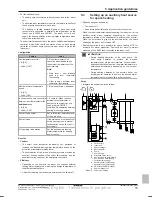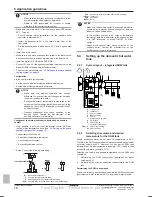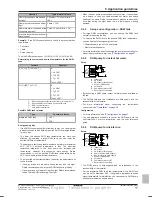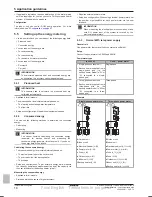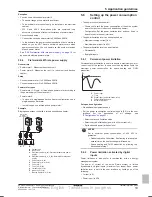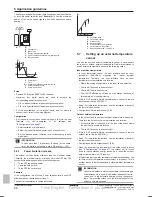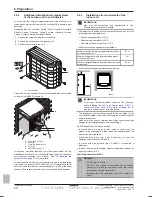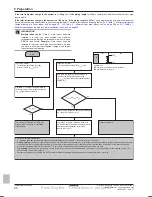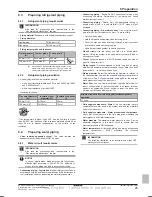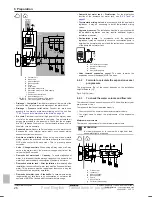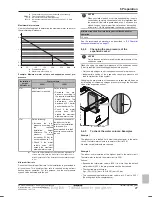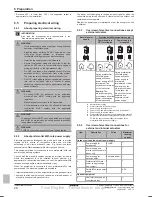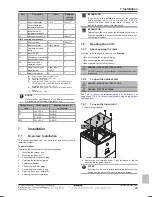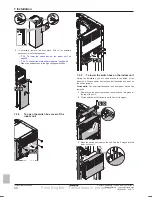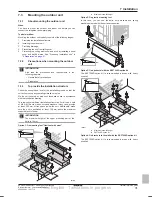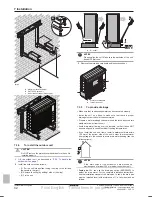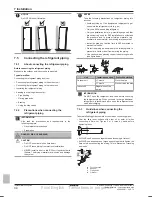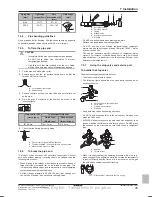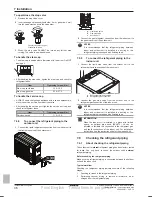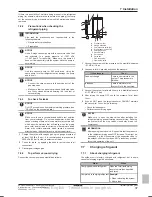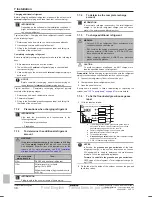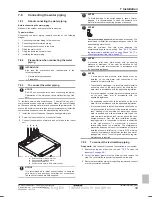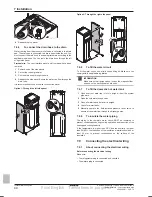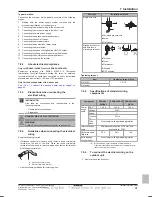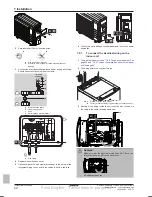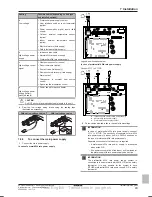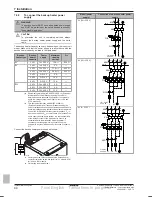
7 Installation
Installer reference guide
29
ERGA04~08DAV3(A) + EHVH/X04+08S18+23DA
Daikin Altherma – Low temperature split
4P495248-1 – 2017.12
Item
Description
Wires
Maximum
running
current
7
Room thermostat
3 or 4
100 mA
(b)
8
Outdoor ambient
temperature sensor
2
(b)
9
Indoor ambient
temperature sensor
2
(b)
10
Heat pump convector
2
100 mA
(b)
Field supplied components
11
Shut-off valve
2
100 mA
(b)
12
Electricity meter
2 (per meter)
(b)
13
Domestic hot water
pump
2
(b)
14
Alarm output
2
(b)
15
Changeover to external
heat source control
2
(b)
16
Space cool/heat
operation control
2
(b)
17
Power consumption
digital inputs
2 (per input
signal)
(b)
18
Safety thermostat
2
(d)
(a)
Refer to name plate on outdoor unit.
(b)
Minimum cable section 0.75 mm².
(c)
Cable section 2.5 mm².
(d)
Cable section 0.75 mm² till 1.25 mm²; maximum length:
50 m. Voltage-free contact shall ensure the minimum
applicable load of 15 V DC, 10 mA.
(e)
Cable section 0.75 mm² till 1.25 mm²; maximum length:
500 m.
(f)
Cable section 1.5 mm².
NOTICE
More technical specifications of the different connections
are indicated on the inside of the indoor unit.
Backup heater
type
Power supply
Required number of
conductors
*3V
1N~ 230 V
2+GND
*6V
1N~ 230 V
2+GND
3~ 230 V
3+GND
*9W
3N~ 400 V
4+GND
7
Installation
7.1
Overview: Installation
This chapter describes what you have to do and know on-site to
install the system.
Typical workflow
Installation typically consists of the following stages:
1
Mounting the outdoor unit.
2
Mounting the indoor unit.
3
Connecting the refrigerant piping.
4
Checking the refrigerant piping.
5
Charging refrigerant.
6
Connecting the water piping.
7
Connecting the electrical wiring.
8
Finishing the outdoor installation.
9
Finishing the indoor installation.
INFORMATION
If you have limited installation space, do the following
before installing the unit in its final position:
"7.8.5 To
connect the drain hose to the drain" on page 40
. It
requires to remove one or both side panels.
INFORMATION
Depending on the units and/or the installation conditions, it
might be necessary to connect electrical wiring before you
can charge refrigerant.
7.2
Opening the units
7.2.1
About opening the units
At certain times, you have to open the unit.
Example:
▪ When connecting the refrigerant piping
▪ When connecting the electrical wiring
▪ When maintaining or servicing the unit
DANGER: RISK OF ELECTROCUTION
Do NOT leave the unit unattended when the service cover
is removed.
7.2.2
To open the outdoor unit
DANGER: RISK OF ELECTROCUTION
DANGER: RISK OF BURNING
See
"7.5.8 To connect the refrigerant piping to the outdoor unit" on
page 36
and
"7.9.6 To connect the electrical wiring on the outdoor
unit" on page 41
.
7.2.3
To open the indoor unit
1
Remove the top panel.
5×
T25
2
Remove the user interface panel. Open the hinges at the top
and slide the top panel upwards.
NOTICE
If you remove the user interface panel, also disconnect the
cables from the back of the panel to prevent damage.
Final English - Tanslations in progress

